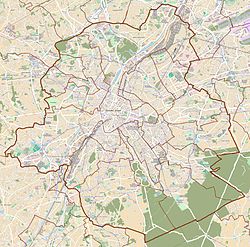Namur Gate
| Namur Gate | |
|---|---|
| Part of Second City Walls of Brussels | |
| Brussels, Belgium | |
 The Namur Gate at the end of the 18th century | |
| Coordinates | 50°50′18″N 4°21′43″E / 50.83833°N 4.36194°E |
| Type | City gate |
| Site history | |
| Built | 14th century |
| Materials | Stone |
| Demolished | 1784 |
The Namur Gate (French: Porte de Namur, pronounced [pɔʁt də namyʁ]; Dutch: Naamsepoort) was one of the medieval city gates of the second walls of Brussels, Belgium. Built in the 14th century, it was demolished in 1784 during the construction of the Small Ring (Brussels' inner ring road).
In the 21st century, the Porte de Namur (French) or Naamsepoort (Dutch) more commonly denotes the Ixelles neighbourhood where the gate formerly stood. This area is served by Porte de Namur/Naamsepoort metro station on lines 2 and 6 of the Brussels Metro.
History
[edit]The city gate was originally known as the New Gate of Coudenberg (Dutch: Nieuwe Coudenbergse Poort), to distinguish it from the old gate located in the first walls, and it used to connect the Rue Entre deux Portes/Twee Poortenstraat (current Rue de Namur/Naamsestraat) to the Chemin d'Ixelles/Elsenseweg (current Chaussée d'Ixelles/Elsensesteenweg).[1][2]
During the construction of the boulevards of the small ring, two neoclassical toll pavilions were built, designed by the architect Auguste Payen (assistant to the city architect, Nicolas Roget) in 1836. The tolls were abolished in 1860, and the buildings were moved to the entrance of the Bois de la Cambre/Ter Kamerenbos three years later. Removing barriers then permitted the Namur Gate area to develop.[1][3]
In 1866, the pavilions were replaced by the monumental Brouckère Fountain, which was raised in memory of the former mayor of the City of Brussels, Charles de Brouckère, designed by the architect Henri Beyaert and by the two sculptors Pierre Dunion and Edouard Fiers. The monument was dismantled in 1955 to allow the rearrangement of boulevards in preparation for the 1958 Brussels World's Fair (Expo 58). It was reinstalled in Laeken, on the Avenue Jean Palfyn/Jean Palfynlaan, opposite the King Baudouin Stadium, in 1977.[1][4]
-
17th-century engraving of the walls of Brussels, by Wenceslas Hollar
-
The Namur Gate on the 18th-century Ferraris map
-
One of the two former toll pavilions of the Namur Gate, now at the entrance of the Bois de la Cambre/Ter Kamerenbos
The "Namur Gate" district
[edit]The names Porte de Namur in French or Naamsepoort in Dutch ended up designating the whole of the Ixelles neighbourhood, which at the beginning of the 20th century became one of the most popular places in Brussels' upper town, a meeting place for the wealthy class and artists. At that time, the district had many cafés, chic restaurants, luxury shops, performance venues, and later cinemas.[5][6]
The modernisation of the road infrastructure in the second half of the 20th century ended this period by transforming the district into a place of transit for cars. The Rue du Bastion/Bolwerkstraat, which linked the boulevards to the Chaussée de Wavre/Steenweg op Waver, was removed and replaced by an office tower, the Bastion Tower, and several neoclassical buildings also disappeared (see Brusselisation). Performance venues were transformed into chain stores or fast food outlets.[7]
Nowadays, the Namur Gate area is once again becoming a busy commercial centre, less elitist than in the past, and one of the liveliest districts in the city. It merges in part with the Matongé district, a meeting place for African communities in Brussels.
-
The Namur Gate and the Chaussée d'Ixelles/Elsensesteenweg, c. 1900
-
The Namur Gate in the 1980s
-
The Namur Gate in the 2010s
See also
[edit]- Halle Gate, a part of the 14th-century city wall protecting Brussels
- History of Brussels
- Belgium in the long nineteenth century
References
[edit]Citations
[edit]- ^ a b c Eggericx & Van Quorie 1998, p. 40.
- ^ Hainaut & Bovy 2000, p. 2–3.
- ^ Hainaut & Bovy 2000, p. 4.
- ^ Hainaut & Bovy 2000, p. 5.
- ^ Eggericx & Van Quorie 1998, p. 40–41.
- ^ Hainaut & Bovy 2000, p. 5–8.
- ^ Eggericx & Van Quorie 1998, p. 41.
Bibliography
[edit]- Eggericx, Laure; Van Quorie, Christine (1998). Les Boulevards extérieurs de la Place Rogier à la Porte de Hal. Bruxelles, ville d'Art et d'Histoire (in French). Vol. 22. Brussels: Centre d'information, de Documentation et d'Etude du Patrimoine.
- Hainaut, Michel; Bovy, Philippe (2000). À la découverte de l'histoire d'Ixelles : Porte de Namur (PDF) (in French). Vol. 7. Brussels: Échevin de l'information.
External links
[edit] Media related to Namur city gate (Brussels) at Wikimedia Commons
Media related to Namur city gate (Brussels) at Wikimedia Commons









